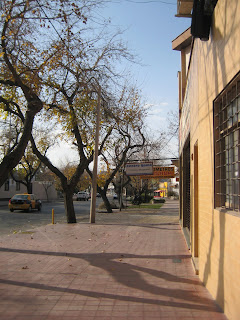1) The apartment building. The balcony closest to the foreground is ours.
2) Out the gate at the bottom of the stairs and headed toward Calle San Juan.
3) As I turn onto San Juan, I always pass the same man sitting on this doorstep and every day he stares at me because I'm usually running to make it to class on time.
4) The furthest building away with the green facade is a dance club (boliche) called the Apeteco. It's the easiest way to tell people where I live because everyone seems to know it, whether they admit to going there or not. I went to check it out with Giselle last Saturday and when I asked for a margarita, they gave me a vodka on the rocks.
5) This store on the corner always confuses me because they have hung a gigantic temperature gauge outside to advertise their business---they sell auto parts of some sort. From a distance, I always think it's a clock that can tell me what time it is (and whether I'm going to be late). When I realize it's not a clock but a temperature gauge, I think that it might tell me what the current temperature is. But, it doesn't read the actual temperature so I am consistently frustrated by its uselessness. (Note: If I really need to know the time, I peek into stores along my route until I find one that has a clock on the wall that I can see from the street.)

6) Now we're just a couple blocks from school. On your right is a secondary school. Don't try to walk by around 6 or 7pm because you will get stuck trying to navigate through a mass of adolescents.
7) Every morning I stop at this panadería for a factura (except for the mornings when I am desperately late or going to the gym after class). If I don't get a factura in the morning, I stop by in the afternoon for an alfajor. They also have the best bread on the block.
8) The supermercado is one of the only things open late on Saturday or (at all) on Sunday. If you have not planned your food shopping well, you can make a desperate stop here for some basics. However, they do not sell fruits or veggies.
9) And here we are! This is the Intercultural where I have my classes each day.


































